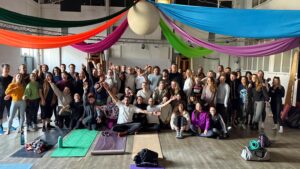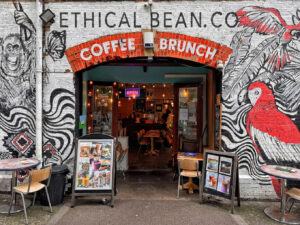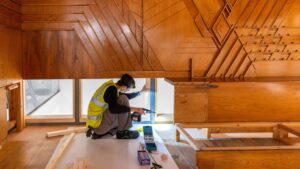
Mattia from Community Yoga Project on the joy of human connection
Exploring the health advantages of belonging to something bigger than ourselves
In cities, we have less opportunity to stare aimlessly at the sky or find ourselves experiencing the particular pleasure we get from walking amidst blossoms, flowers, trees, and birds. Research shows that we’re kinder in parks, and London is known all over for its legendary proliferation of green spaces. It all started here, too. Queen Victoria, the epoch-defining monarch, lent her name to London’s very first public park, as a response – an act of kindness – bestowed upon East Londoners suffering from pollution caused by local industry.
The more recent Queen Elizabeth Olympic Park is another massive legacy project, designed with the next thousand years in mind, and as much about new homes, sporting venues and gleaming cultural institutions as it is about trees. Its ongoing development is orchestrated by London Legacy Development Corporation (LLDC), a remarkable quango set up to manage the transformation of an area which spans four London boroughs. When the councils finally take back control in a few years time, the hope is for a fitting legacy of the 2012 Olympics; a ‘living test bed for better urban futures’. A veritable field of dreams. That’s the vision.
“We hope that what we have in planning will encourage developers to do the right thing,” says Ruth Holmes, Design Principle at LLDC, who is working to create a more sustainable future for our city’s public parks. “We want to encourage better practice.” From lengthy biodiversity action plans, to insect hotels, Ruth speaks on the Corporation’s many successful environmental legacies, such as their work with local volunteer group Tree Musketeers, and the disease-resistant elm trees planted by Gainsborough School. The local community is excited to see the legacy of the mobile gardens in front of Hackney Bridge, a wonderful opportunity to engage in one of Britain’s best kept secrets; allotments.

In the new Fish Island Village development, some rooftops have been designed as urban gardens with allotment boxes. Residents convene, sharing growing tips and the produce of their labours. Children growing up on this estate will put down their own roots on these rooftops, which will no doubt entangle with those of their neighbours, in London’s latest urban jungle. But according to Mark Harton, secretary of the legendary Manor Garden Society, allotments can tend to be a bit of a headache for local councils, which may explain how his fellow allotment holders find themselves hoping that they win a small battle in a war – a war which often sees community uprooted.
Dapper, dashing, debonaire, Mark led me round an allotment site, sandwiched between a railway line and a prospective development on the Eastern border of the Park, and told me a solid story. Are you sitting comfortably? It’s a cracker.
Once upon a time, following in the fertile footsteps of Queen Victoria, the gentle Major Arthur Villiers bequeathed a massive wedge of his land to local people, and told them to grow vegetables. They did; the original Eton Manor allotment plots were the perfect East London contemporary narrative, where the children of industrial families grew plums. A little slice of paradise.
When London won the Olympic bid, allotment owners were given two new plots of land, but in 2014, they were evicted from their new Eton Manor plot (despite it only having been acquired in 2009, this piece of land had sentimental value to older allotment keepers, having retained Villier’s legacy by name alone).
Mark walked me around the remaining rectangle of land offered to the Manor Garden Society, in Pudding Mill Lane. It is a strange site; I’ve cycled past it many times, oblivious to the industrious work of East London’s proud gardening community. It feels a bit desolate. Even this plot – the last remaining sign of Major Villier’s generous legacy to poorer East Londoners – is threatened. Studies show that recently submitted plans for a new high-rise development will obscure the gardens from all but two hours of sunlight per day.
Mark is incredibly proud of his gardening community, and it’s obviously a community asset like no other. He showed me quaint garden huts, lovingly built and decorated; blossoming cherries and almonds; strange South American plants brazenly mingled with shy and retiring English cucumbers. He showed me the beehives, which harvested over a hundred pounds of honey last season.
When the plans were submitted, Mark and the Garden Society decided that enough was enough. They’d been chucked off their land, and wanted justice, so they organised themselves, and this bunch of common gardeners, pitchforks and all, took the LLDC to the European Supreme Court of Justice, where they won their case. The Court decreed that the LLDC’s planning department work with the Manor Gardening Society to create a working solution.
Now, the gardeners are hopeful that the corporation’s planning department will work with them to create a solution where everybody could win; in a perfect world, the remaining allotments will not only survive, but thrive, as an example of best practice in building sustainable, future-proofed cities. Mark was hopeful; he loved using gardening analogies in his jovial, chipper banter. “I can feel a good wind coming this Spring,” he says.

It’s important not to paint LLDC as the big, bad, development wolf. The remit of this organisation is simply huge. All over Queen Elizabeth Olympic Park are testaments to the successful legacy LLDC hopes to create. There are many moving parts, and over time, there will be millions of beating hearts.
The Hothouse is a name given to a cute little mini-Kew Gardens temperate house installed in the International Quarter London’s shiny new build. In it are fruit which the architects suggest will grow outdoors in Britain in 2050 if the current climate change forecasts come to pass. There is an oak planted in a Great British Garden, in the shadow of the London stadium. The oak was seeded at Kew Gardens. Fingers crossed it grows big and mighty, like all oaks should. An Olympic oak, around which millions of people will be inspired, in a thriving landscape, filled with a vibrant community, helping to turn the wheels of a massive vision; East London 2.0 – a world class hub of education, arts, culture and innovation.
So that’s how we all play a part in creating a sustainable future; our town planners do their bit, and we can do ours. Pop yourself on an allotment waiting list, and in the meantime, grow pea shoots on your windowsill. Wildflowers will attract those all-important bees. Buy local vegetables from East London’s many growing schemes and small farmers. Throw your seeds out on the street in a bit of guerrilla gardening.
If you don’t have the privilege of a sunlight-facing seed box, then simply put on your flip flops and jog on to the marshes where free food is available from Mother Nature. Wood ear fungus, chickweed and hairy bitter cress, laced with blackcurrant sage and pretty violet flowers, that’s what John the Poacher might gather on a day’s foraging. His iconic name comes from his youth; he still ferrets for rabbits on farmland and will happily catch you one to order.
“My parents were proper religious. All creatures great and small; I say eat the lot of them all,” John told me over a cheeky liquid lunch at The Cock Tavern in Hackney. He is proud of his own legacy. His foraging has played a part in many an East London success story, from the elderflower he provided for Square Root’s popular cola, to the fennel seeds he harvested for Land Chocolate. “One man’s waste is another man’s gold,” he tells me. “When I drop seeds off at Land Chocolate, I pick up their waste of bean husks, which I take to beer makers.”
The poorest parts of the world provide an important example of the circular economy; at the bottom of the human food chain are the litter pickers, who harvest what can be sold. Can John’s lesson in waste disposal teach us anything? Could our litter bins actually be goldmines? Our buildings actually generate energy? The answer is a very firm yes. A circular economy which may see less waste, less haste; that’s the dream.
Cities are hard to future-proof, and the Olympic legacy is often a heavy weight for cities to carry. Pity the many cities littered with hollow shells of stadiums erected under light of the Olympic flame. They lay rusting like decaying coliseums, waiting for the dream to be declared failed. Our country’s leaders would have us believe that East London’s Spring is just beginning; each child, in each apartment, a blossoming domestic flower in a huge urban garden, designed to come into blossom sometime soon. Fruit from this garden will take time to emerge: the next Beatles, the next Darwin, the next Berners-Lee. Who knows?
The LLDC are preparing this part of our city for a new Spring – one that will hopefully last hundreds of years. They are doing their bit, planting the seeds in preparation to bloom and the harvest to follow, when hopefully, all our plates will be filled with bounty. Let’s do our bit too; it’s time to get our fingers dirty. Let’s enjoy the balmy, frivolous joys of Spring; let’s help to create a better environment and plant our own seeds for the future. Better get your gardening gloves on.

Exploring the health advantages of belonging to something bigger than ourselves

Your timely reminder to go visit these amazing restaurants, bars and cafes this summer while we wait for better bridge access…

The twist and turns of post-Olympics decision-making that brought 250,000 objects to Here East
A joint venture in collaborative local media from:


In partnership with

Regulated by IMRESSS, the Independent Monitor for the Press CIC.
For more info on our complaints policy, or to make a complaint, visit FAQ.
